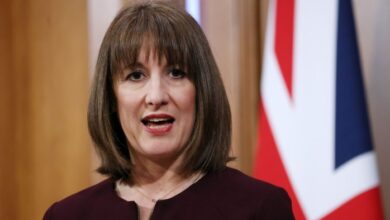Trump warns of 50% tariff on EU imports from next month

Donald Trump says he plans to impose a 50 per cent tariff on imports from the EU from next month, adding that talks with the bloc are “going nowhere” as he increases his threat to upend global trade.
The move escalates the trade war with the EU barely two weeks after the US agreed with China to slash tariffs in a pact that comforted global investors.
In a post on Truth Social on Friday, Trump attacked the bloc for “Trade Barriers, VAT Taxes, ridiculous Corporate Penalties, Non-Monetary Trade Barriers, Monetary Manipulations, [and] unfair and unjustified lawsuits against Americans Companies”.
He added: “Our discussions with them are going nowhere! Therefore I am recommending a straight 50% Tariff on the European Union, starting on June 1, 2025.”
Such a level would be more than double the tariff rate the US president announced for the EU on his self-styled “liberation day” on April 2, and could reduce German GDP by 1.7 per cent over three years, according to Capital Economics.
Trump’s comments come after repeated reversals from the US president on some of his most aggressive tariff proposals, which hammered markets in the weeks after “liberation day”.
In TV interviews after Trump’s post, US Treasury secretary Scott Bessent signalled that the president’s threats were designed to put pressure on the EU during talks about a possible deal.
“I think this is in response just to the EU’s pace,” Bessent told Fox News. “I would hope that this would light a fire under the EU.”
In another interview with Bloomberg TV he said he expected the US to seal “several large deals” over the next couple of weeks.
Friday’s tariff threats from Trump blindsided European officials, after cordial talks with the US at this week’s G7 finance ministers summit in the Canadian Rockies.
The US was “treating us like friends again”, said one European official.
Stock markets fell following Trump’s posts threatening the EU and Apple. The S&P 500 was 0.7 per cent lower on Wall Street during lunchtime trading, having recovered from a steeper decline at the opening bell. The Stoxx Europe 600 closed 0.9 cent lower.
Trump’s threat to impose higher tariffs on EU goods came shortly after he warned Apple that he would impose 25 per cent tariffs on the company’s imported iPhones if they continued to be produced internationally.
Austan Goolsbee, president of the Chicago Fed and a voter on US interest rates, told CNBC on Friday that the 50 per cent tariff on the EU and another 25 per cent levy Trump threatened on Apple “would be really scary for the supply chain” and had raised the bar for US rate cuts “a little higher”.

The move “puts a dent in the view that markets will rein in Trump”, said Andrew Pease, chief investment strategist at Russell Investments.
US trade representative Jamieson Greer was due to talk to EU trade commissioner Maroš Šefčovič later on Friday.
The US imposed a 20 per cent “reciprocal” rate on most EU goods in April, but halved it until July 8 to allow time for talks. It has retained 25 per cent levels on steel, aluminium and car parts and is promising similar action on pharmaceuticals, semiconductors and other goods.
The bloc must now choose whether to retaliate with counter-tariffs or accede to US demands to make concessions.
Member states have approved a €21bn package of up to 50 per cent tariffs from July 14 on US items such as maize, wheat, motorcycles and clothing.
The European Commission is still consulting on a €95bn list of possible measures, which includes Boeing aircraft, cars and bourbon whiskey.
Exporters and stocks linked to the health of the European economy such as banks were hit hard by Trump’s threats, with carmaker Stellantis dropping 4.6 per cent and Deutsche Bank shedding 4.2 per cent.
Traders moved to price in faster interest rate cuts from the European Central Bank to support a tariff-hit economy.
The chance of a third quarter-point rate cut by the end of this year rose to more than 30 per cent compared with roughly 15 per cent earlier on Friday, according to levels implied by swaps markets.
“This is a reminder that the trade uncertainty is in no way over,” said Kasper Elmgreen, chief investment officer for fixed income and equities at Nordea Asset Management. “Every day that we don’t have a deal, we risk serious economic damage.”
US officials have been frustrated by the EU’s failure to offer the kind of concessions other countries have, with Howard Lutnick, US commerce secretary, saying on Thursday that Brussels was “impossible” to negotiate with.
Washington wants Brussels to reduce import barriers to diminish the size of the US’s trade deficit in goods with the bloc, which totalled $192bn in 2024.
The Trump administration considers EU food and product standards protectionist and wants the bloc to unilaterally drop tariffs. The EU has proposed that both sides scrap tariffs on all industrial and some agricultural products.
The European Commission said it would not comment ahead of the call between Greer and Šefčovič.
Additional reporting by Emily Herbert, Peter Foster, Steff Chávez, Claire Jones and Myles McCormick
https://www.ft.com/__origami/service/image/v2/images/raw/https%3A%2F%2Fd1e00ek4ebabms.cloudfront.net%2Fproduction%2F8ca1f23d-71dc-4484-976b-40a95d6f9451.jpg?source=next-article&fit=scale-down&quality=highest&width=700&dpr=1
2025-05-23 12:06:09




